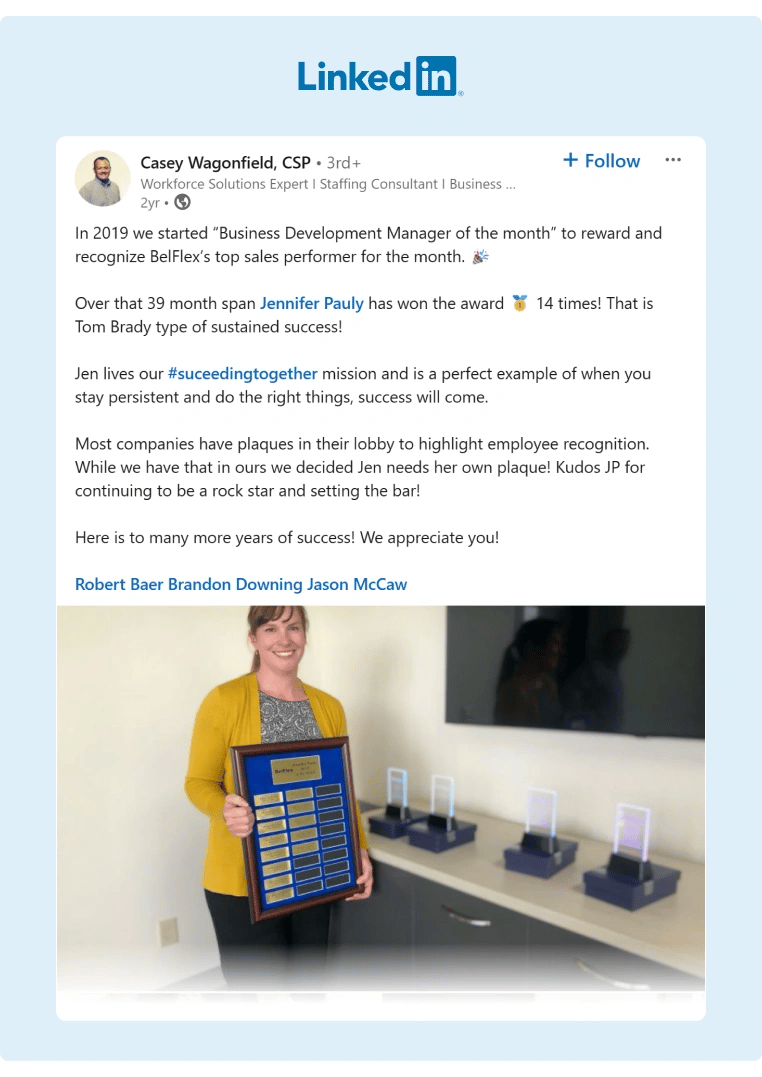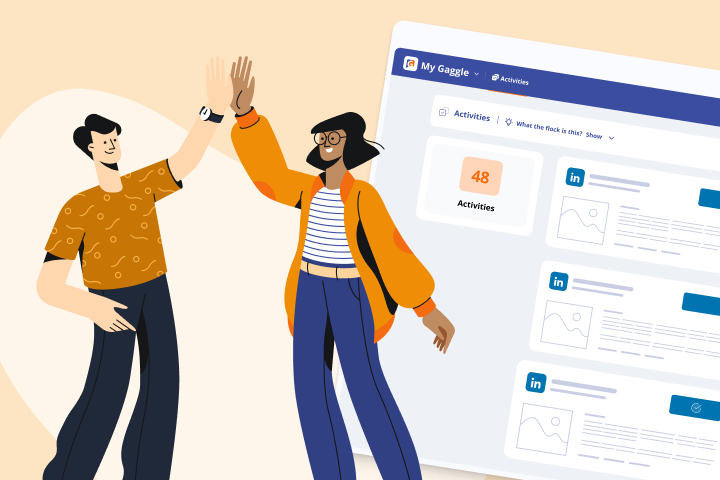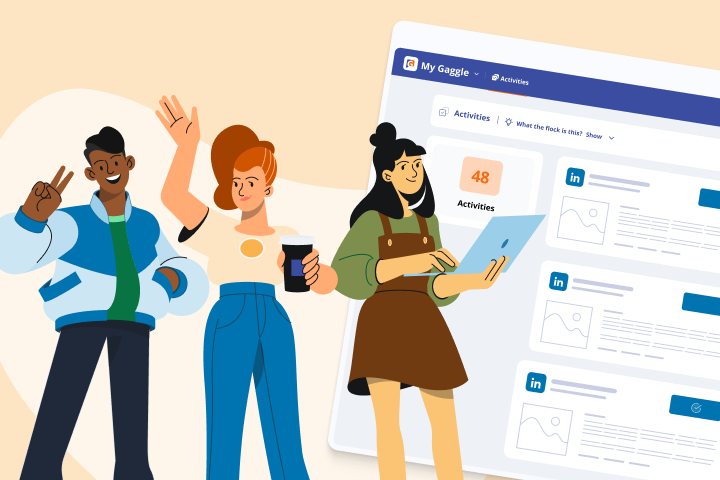How to Craft a Winning Employee Engagement Strategy
You’ve heard of employee engagement, you know it works, but are you aware that having an employee engagement strategy is what actually moves the needle for your business? If you’re serious about seeing big ROI numbers, creating (and then executing) that strategy should be your top priority.
In this blog post, we'll talk about what is an employee engagement strategy, why employee engagement strategies matter, and some of the key steps you need to know when developing them. You’ll also see some real-life examples of successful strategies and learn about the future trends in employee engagement.
Let’s dive in.
What Is an Employee Engagement Strategy?
An employee engagement strategy is the foundation for fostering a motivated and dedicated workforce. Think of it as the blueprint for cultivating a motivated and dedicated team — a roadmap outlining how to ignite passion and commitment among employees.
It's about fostering a workplace where employees aren't just going through the motions but genuinely care about the company's success. Moreover, it's about instilling a sense of value and excitement in every job role. By focusing on what inspires and empowers employees, companies can create a thriving environment where everyone works together towards common goals.
Benefits of an Employee Engagement Strategy
Introducing an employee engagement plan comes with many perks that can help your organization succeed and grow. Let's look at some of the most important benefits of an employee engagement strategy.
Enhanced Profitability
Engaged employees are more motivated and committed to their work, leading to increased productivity levels. When employees feel valued and connected to the company's mission, they are more likely to go the extra mile to deliver quality results. According to statistics, organizations with highly engaged employees can have 23% higher profits.
Improved Employee Retention
A strong employee engagement strategy fosters a sense of belonging and loyalty among team members. As a result, employees who feel purpose and passion are 3x more likely to stay with a company for the long term, reducing turnover rates and associated costs.
Heightened Brand Advocacy
Engaged employees are your most enthusiastic brand ambassadors. When they believe in the company's vision and values, they naturally become advocates for the brand, promoting it to their networks and magnifying its reputation in the marketplace. In fact, social media managers say that 50% of employees regularly engage with branded social media posts.
Increased Social Media Engagement
An engaged workforce is more likely to actively participate in sharing company content on social media platforms. Research shows that content shared by employees receives twice as much engagement as content shared by official company accounts, amplifying the reach and impact of your brand message.

Source: Jim Fecile
Improved Customer Satisfaction
Employees who are passionate about their work are more likely to deliver exceptional customer service. When employees feel valued and motivated, they are naturally inclined to go above and beyond to meet customer needs and exceed expectations. This results in higher levels of customer satisfaction up to a whopping 89%, repeat business, and positive word-of-mouth referrals, ultimately contributing to the long-term success and profitability of the organization.
Key Steps for Developing an Employee Engagement Strategy
To reap the full benefits, here are seven key steps to develop a strong employee engagement strategy.
1. Evaluate Current Engagement Levels
Begin by evaluating the existing engagement levels within your organization. Conduct surveys, interviews, and assessments to gauge employee satisfaction and identify areas for improvement. By understanding where you currently stand, you can pinpoint specific areas that require attention and develop targeted strategies to address them effectively.
2. Establish Clear Objectives
Set clear and measurable objectives that align with your organizational values and mission. Define what success looks like for your employee engagement efforts and establish specific goals to work towards. Whether it's improving communication, boosting employee morale, or enhancing teamwork, ensure that your objectives are realistic, achievable, and aligned with the overall vision of the company.
3. Enhance Communication and Feedback Channels
Implement transparent communication channels and feedback mechanisms to facilitate open dialogue between management and employees. Create avenues for employees to voice their opinions, share feedback, and express concerns. Whether through regular team meetings, suggestion boxes, or digital platforms, fostering a culture of communication and transparency is essential for building trust and engagement within the workforce.
4. Recognize and Reward
Develop systems to acknowledge and reward employee contributions. Implement employee recognition programs that celebrate achievements, milestones, and exemplary performance. Whether through verbal praise, monetary incentives, or other forms of recognition, demonstrating appreciation for employees' hard work and dedication is vital for boosting morale and fostering a positive work environment.

5. Invest in Growth
Invest in employee growth and skill enhancement opportunities. Provide training programs, workshops, and professional development opportunities that empower employees to expand their knowledge and expertise. By investing in their growth and development, you not only increase their job satisfaction but also equip them with the skills and resources needed to excel in their roles and contribute to the company's success.
6. Lead by Example
Encourage active participation and support from leadership in the employee engagement process. Ensure that leaders are visible, approachable, and actively involved in fostering a positive work culture. Encourage them to lead by example, communicate openly with employees, and demonstrate a genuine commitment to employee engagement initiatives. When leaders prioritize and champion employee engagement, it sets a powerful example for the rest of the organization.
7. Adapt and Improve
Regularly review and adjust your employee engagement strategy based on feedback and results. Monitor key metrics, solicit employee input, and assess the effectiveness of your initiatives. Be willing to adapt and make changes as needed to ensure that your strategy remains relevant and impactful. Continuous evaluation and adaptation are crucial for sustaining long-term engagement and driving ongoing improvement within the organization.
Executing Your Employee Engagement Strategy With GaggleAMP
Integrating employee engagement strategy ideas along with using an employee advocacy tool like GaggleAMP can bolster your employee advocacy program efforts. Together, they can amplify your program’s effectiveness and drive greater employee participation.
Here's how you can implement these strategies within GaggleAMP’s platform:
Utilize GaggleAMP's Engagement Tools
Leverage GaggleAMP's Community module, where you can open up discussion forums to foster engagement and collaboration among employees. Encourage them to share their thoughts, ideas, and feedback within the platform to drive meaningful interactions with one another. And, if you’re a fully remote company like ours, Community helps us share announcements and events to foster a stronger community among our teammates.

Align Advocacy Goals With Engagement Objectives
Customize your advocacy campaigns within GaggleAMP to align with your organization's employee engagement objectives. For example, if your goal is to improve communication, focus on sharing relevant updates and fostering discussions around company initiatives.
An activity from our internal Gaggle targeting those in the Financial Services industry.
Provide Recognition and Rewards
You can apply GaggleAMP's gamification features to recognize and reward employees for their advocacy efforts. Implement leaderboards, badges, and rewards programs to incentivize participation and motivate employees to actively engage in advocacy activities.
Facilitate Training and Development
GaggleAMP also provides training resources and development opportunities for employees to elevate their advocacy skills. You can find tutorials and resources both for managers and employees in our Knowledge Center to educate employees on effective advocacy practices and encourage continuous learning. And, all Gaggle Members have access to our Member training to get the most out of their personal branding initiatives.
Encourage Leadership Involvement
Leverage GaggleAMP to facilitate leadership involvement in advocacy initiatives. Encourage executives and managers to actively participate in advocacy campaigns, share company updates, and provide feedback to employees, demonstrating their commitment to employee engagement.
For example, take a look at our own CEO Glenn Gaudet’s post:

Source: Glenn Gaudet
Measure Engagement Metrics
GaggleAMP's analytics tools help with tracking engagement metrics specific to your advocacy program. Monitor employee participation, content-sharing activities, and feedback within the platform to assess the impact of your engagement strategies and make data-driven decisions for optimization.
An example Benchmark Report from the GaggleAMP platform.
Employee Engagement Strategies of Successful Companies
Crafting the perfect employee engagement strategy isn't a one-size-fits-all endeavor. Every company has its own story, goals, and values, shaping their strategic approach. But amid this diversity, some strategies stand out as particularly effective.
Below, we’ll delve into the employee engagement strategies of successful companies, offering valuable insights and inspiration for cultivating a motivated and committed workforce.
Intuit: Employee Appreciation
One of the most impactful strategies for boosting employee engagement is to publicly recognize and appreciate your team's efforts on social media. This not only fosters loyalty among employees by acknowledging their contributions, but it also showcases your organization as one that values its workforce.
Intuit is a prime example of this approach. It recognizes and celebrates its employees, giving them credit for making Intuit an extraordinary place to work.

Source: Intuit
GE: Mentorship Program and Growth Opportunities
GE's Commercial Leadership Program (CLP) is another great example of a strategic approach to enhancing employee engagement. By offering structured career development, employees are motivated by the opportunity for growth and advancement.
With challenging roles and supportive leadership, the program fosters a culture of continuous learning and professional advancement, resulting in heightened employee satisfaction and commitment.

Source: GE
Ernst & Young (EY): Building Professional Networks
EY’s strategic approach to employee engagement centers around fostering professional networks. Through EY Professional Networks, employees connect, mentor, and develop leadership skills within diverse communities. The idea behind these networks is to offer support and opportunities for growth, creating a sense of belonging and engagement among employees from all backgrounds so that nobody feels neglected.

Source: EY
Salesforce: Employee Volunteering
Salesforce's employee engagement strategy revolves around volunteering and giving back to the community. Through initiatives like Volunteer Time Off (VTO) and matching gifts programs, employees actively contribute to causes they care about, harnessing their skills to make a meaningful impact. By empowering employees to give back to their communities, Salesforce fosters a sense of purpose and engagement among its workforce.

Source: Salesforce
GaggleAMP: People-First Culture Model and Company Benefits
At GaggleAMP, our employee engagement strategy centers around fostering a people-first culture and providing comprehensive company benefits. By aligning values with actions, we create an environment where honesty, continuous growth, teamwork, coherence, and gratitude thrive. Moreover, our benefits package and learning opportunities, demonstrates our commitment to supporting employees’ well-being and professional development, driving higher engagement and satisfaction.
Source: GaggleAMP
Future Trends in Employee Engagement
So, what does the future hold for employee engagement? Let’s take a look at some trends that will help improve employee engagement.
1. Remote Work Adaptations
In recent years, the global shift to remote work has accelerated (due to the COVID-19 pandemic), and it's here to stay. As a result, according to Gallup, companies will need a long-term hybrid work strategy.
To reduce burnout and improve retention, companies will need to focus on adapting engagement strategies to accommodate remote teams. This includes fostering connection, collaboration, and well-being in virtual environments.
2. Healthy Work-Life Balance
Not only did the pandemic make remote and hybrid work popular, but it also shortened the work week for some companies. Following a flexible workplace model is growing in popularity, with 59% of companies open to a four-day work week. Benefits of a shorter work week include happier employees, increased productivity, reduced costs, lower cases of burnout, etc.
Whether it's accommodating flexible hours, remote work options, or alternative schedules, providing flexibility is essential for engaging employees and providing a healthy work-life balance.
3. Digital Employee Experience Platforms
As remote and/or hybrid work roles continue to grow, there will be a need for centralized digital employee experience platforms.
The rise of digital employee experience platforms will revolutionize how organizations engage with their workforce. These platforms will centralize communication, collaboration, and engagement initiatives, providing employees with seamless access to resources, information, and support.
4. Data-Driven Engagement Strategies
Data analytics will play a crucial role in shaping future engagement strategies. Organizations will leverage employee data to gain insights into engagement levels, identify trends, and predict future behaviors, enabling them to tailor initiatives and interventions for maximum impact.
5. Leveraging Social Media
Social media opens up new ways for employees to communicate, share and discuss ideas, and get updates from leadership. By using social media internally, companies can boost teamwork and keep everyone on the same page. Starting inside the company and then externally sharing messages that showcase company values and culture is a smart way to build a strong team and meet your employee engagement goals.
Ready To Streamline Your Employee Engagement Strategy Efforts?
Navigating the complexities of employee engagement strategies is crucial for organizational success. From personalized experiences to flexible work arrangements and innovative communication channels, the future of employee engagement is bright.
To simplify and enhance your efforts, consider GaggleAMP. With its comprehensive suite of features, our platform helps you streamline the implementation of these strategies, ensuring a highly engaged and motivated workforce.
Ready to save time and maximize your employee engagement strategy efforts? Schedule a demo today.








